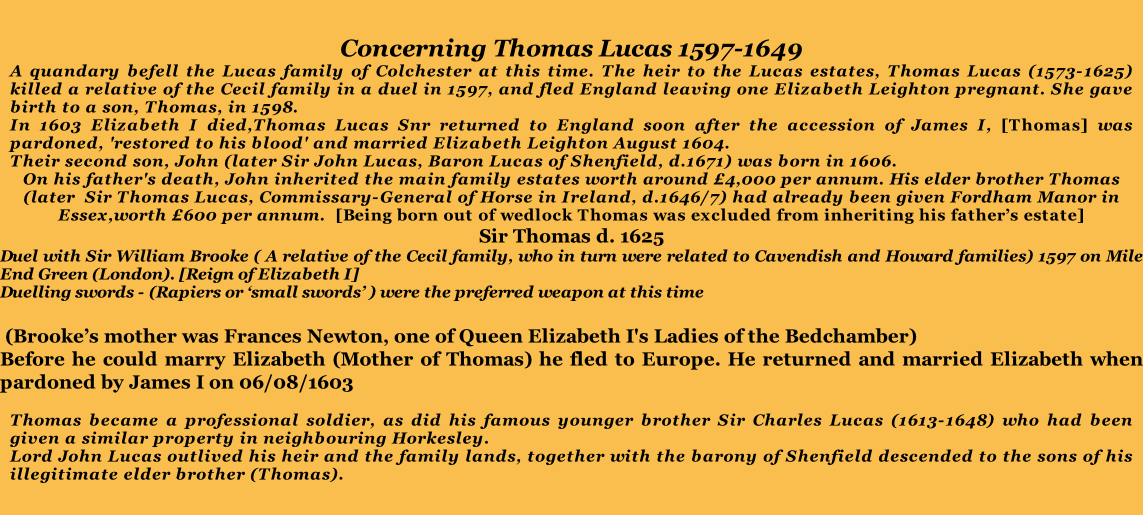


LUCAS
-THOMAS Born 1573
Brooke, a ‘comely youth disposed to follow the court’ and one of the Earl of Essex’s brilliant young men, was brought into Parliament for Rochester by his father, the lord warden of the Cinque Ports and lord lieutenant of Kent. He may have served with the Captain Brooke who in September 1589 was commanding a company in the forces assisting Henri of Navarre—possibly the same company later described as having crossed from Sandwich to Flushing. In September 1591 he was knighted before Rouen by the Earl of Essex and was later that year at Dieppe.
In autumn 1597 Brooke and (Sir) Robert Sidney stood for the county. Brooke’s brother Henry, 11th Lord Cobham, was ‘much grieved’ to see that Sidney was returned senior Member ‘by the voices of the people, which he would not have believed’. The Queen objected to both candidates being abroad, and Brooke had an additional handicap in that he stood outlawed — presumably for debt—which brought him within the Queen’s instruction that such Members could not take their seats until they had compounded with their creditors. Whether or not he ever took his place in the House of Commons, he did not see the session through. He had made his will 17 June 1597, before setting out on the Islands voyage. In December he added a codicil leaving his brother George his lands, leases and prisoners, writing ‘Your jest and my haste would not suffer me to acquaint you with what I am gone about this morning—what hath called me out so early’. This was a duel at Mile End Green with a son of (Sir) Thomas Lucas, in which Brooke was mortally wounded. His cousin Percival Hart wrote to (Sir) John Leveson, a deputy lieutenant of Kent, 24 Dec., of the ‘misfortune’ of Brooke, who had ‘left many sorrowful friends behind him’. Having been with him most of the day he died, Hart could ‘note the continual concourse of his friends, which was without intermission that came to see him, and of the best sort’. On 24 and 29 Dec. the Privy Council issued warrants for Lucas’s arrest.
William Brooke’s father was Sir William Brooke, 10th Lord Cobham (of Kent) born on 1 November 1527. who was the son of Sir George Brooke, 9th Lord Cobham (of Kent) and Anne Bray. He married, firstly, Lady Dorothy Neville, daughter of Sir George Neville, 3rd Lord Abergavenny and Lady Mary Stafford, before 1559. He married, secondly, Frances Newton, daughter of Sir John Newton and Margaret Poyntz, on 25 February 1559/60 at Palace of Westminster, Westminster, London, England. He died on 6 March 1596/97 at age 69. He was buried at Cobham Church, Cobham, Kent, England. His will was proven (by probate) on 23 May 1597.
He held the office of Member of Parliament (M.P.) for Hythe between 1547 and 1552 He held the office of Member of Parliament (M.P.) for Rochester in 1555. He held the office of Lord-Lieutenant of Kent between 1558 and 1596. He succeeded to the title of 10th Lord Cobham [E., 1313] in November 1558. He held the office of Constable of Dover. He held the office of Lord Warden of the Cinque Ports. He held the office of Ambassador to the Spanish Governor of the Netherlands in 1578 He was invested as a Knight, Order of the Garter (K.G.) on 23 April 1584 He was invested as a Privy Counsellor (P.C.) before 12 February 1585/86. He held the office of Ambassador to the Spanish Governor of the Netherlands in 1588. He held the office of Lord Chamberlain from August 1596 to 1597. His last will was dated 24 February 1596/97.
His step mother was a Neville, Thomas’ second son, John married Joanne Neville in 1628
Sir Thomas - Born 1573 Died 1625
Duel with Sir William Brooke ( A relative of the Cecil family, who in turn were related to Cavendish and Howard families) 1597 on Mile End Green (London). [Reign of Elizabeth I]
Duelling swords - (Rapiers or ‘small swords’ ) were the preferred weapon at this time
(Brooke’s mother was Frances Newton, one of Queen Elizabeth I's Ladies of the Bedchamber)
Before he could marry Elizabeth (Mother of Thomas) he fled to Europe. He returned and married Elizabeth when pardoned by James I on 06/08/1603

